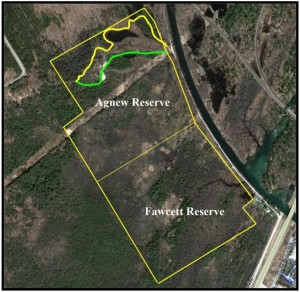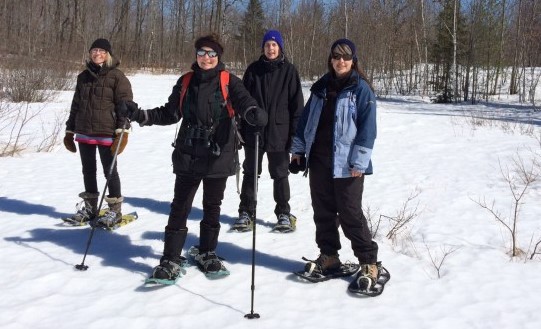Looking after the dozens of protected properties managed by the Conservancy is an arduous and time-consuming task. So the properties have volunteer teams who take on the job of monitoring them on a regular basis.
I am the property team leader for the Robert & Emily Fawcett Natural Area and the adjoining Thomas C. Agnew Nature Reserve in Washago. The properties comprise almost 200 acres of mixed upland forest, ponds, and wetlands adjacent to the Trent Severn Waterway.
The rest of the team is made up of four local people from various walks of life. But we share a common desire to look after the land while enjoying nature in our own backyard.
Our team strives to visit the properties four times per year; one outing for each season. However, agreeing on a date is often like herding cats! Our lives are busy with other commitments so there is a lot of schedule juggling to get the right date and time.
The Fawcett property presents its own challenges as it is mostly wetland making summer visits unbearable if not impossible. So we trek out there in the winter on snowshoes, making our way through the clumps of alder and red-osier dogwood to look for signs of wildlife. We have noted several songbird nests and a large osprey nest at one end of the wetland. It is difficult to determine whether the nest has been used recently although there are osprey in the area during the summer, so it is possible.
Once we enter the trail head at the Agnew Nature Reserve we look for any signs of damage to the trail or signage done either by humans or by Mother Nature.
Our favourite time to tour properties is in early spring when we can see the unusual plant called skunk cabbage. This member of the arum family is able to produce its own heat; enough to melt the snow around it!
One area of concern is the sand pit at the far west side of the property which is visited by partiers who leave behind broken bottles and other garbage. We have hauled out many bags of trash during our visits. Other than that, the hiking trail rarely has any garbage on it. We have noticed damage to the trail markers in the past year however it is likely done by small animals such as squirrels.
We also remove any small trees, or branches that have fallen over the hiking trail. Any vegetation, such as bracken fern, that has grown over the trail is also cut back or cleared off.

An aerial view of the Agnew and Fawcett properties. Agnew has walking trails that are open to the public. Click the map to see a larger version.
There are several small ponds on the property, the result of sand and gravel removal many decades ago. These ponds provide habitat for frogs, turtles, and small invertebrates. Last summer, hundreds of green frog tadpoles were observed sunning themselves in the shallows of the ponds. Other notable signs of wildlife have been sightings of moose droppings and even the moose itself! We have also seen winter tracks of porcupines, coyotes, deer, and rabbits.
Our favourite time to tour properties is in early spring when we can see the unusual plant called skunk cabbage. This member of the arum family is able to produce its own heat; enough to melt the snow around it! It grows in the wet areas along the hydro corridor that runs through the property.
Later on in the growing season we look forward to seeing pink lady’s slipper and downy rattlesnake plantain; two species of fascinating orchids native to our region.
What’s up next for the two properties? Our team discusses possible enhancements to the hiking trail such as re-routing around wet areas, permanent signage, and a map of the trail system at the trailhead. We are also looking into a possible link between the Agnew property and the adjacent Simcoe County Forest Turnbull Tract. As team leader, I correspond with David Hawke, Stewardship Coordinator at the Conservancy, to keep him informed of our team’s visits and to get assistance with any major project.
Written by Gayle Carlyle.


